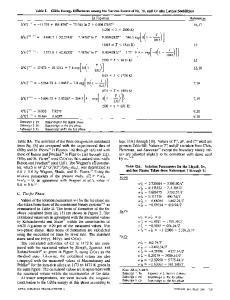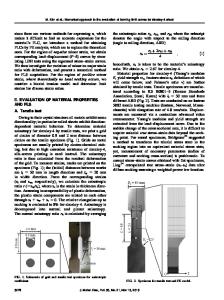Calculation of the forming limit diagram
- PDF / 1,056,768 Bytes
- 13 Pages / 597.28 x 785 pts Page_size
- 26 Downloads / 317 Views
BACKGROUND
IN order to develop the theory to predict the negative minor strain region (or LHS) of the FLD, it is necessary to describe the Jones and Gillis (JG) analysis t~J upon which the present analysis is based. After the Marciniak and Kuczynski (MK) theory t2'3j was proposed, the hypothesis of an initial imperfection remained as the essential element in all subsequent developments. ~4-241 A principal objection to the widely accepted and used MK theory and its many variations is that computational results are extremely sensitive to the precise size of the postulated imperfection. Recently, Jones and Gillis cl,25~have proposed a totally different approach to the biaxial stretching analysis. They based their analysis on three easily observable features from a tensile test of a typical sheet metal. The deformation process is approximated by (I) homogeneous deformation up to maximum load; (II) deformation localization under constant load; and (III) local necking with a precipitous drop in load. WONJIB CHOI, Principal Researcher, is with the Construction Steel Laboratory, Institute of Industrial Science and Technology, Pohang 680, South Korea. PETER P. GILLIS, Professor, is with the Department of Materials Science and Engineering, University of Kentucky, 763 Anderson Hall, Lexington, KY 40506. S.E. JONES, Professor, is with the Department of Engineering Mechanics, University of Alabama, Tuscaloosa, AL 35487. Manuscript submitted November 4, 1988. METALLURGICAL TRANSACTIONS A
Obviously, these features are not precisely what happens in a tension test. For example, during phase I, the deformation is not homogeneous from one grain to another, and during deformation localization (phase II), the load does not remain perfectly constant. The foregoing three features are merely mathematical idealizations of what really happens. They are made in order to provide a solvable set of differential equations. The solutions in the three phases can be considered as asymptotic expansions of the actual process description (material behavior). These expansions are each correct at one point and are extended to points of intersection so as to cover the entire process range up to necking. Therefore, this three-phase descnptlon of the deformation process is not to be treated as a rigorous physical description of the details of sheet deformation. Instead, it is a mathematical approximation to a very difficult problem in plasticity and a problem of some practical interest. The assumptions made in the analysis are ultimately evaluated by the extent to which intermediate and final results approximate actuality. The three stages of deformation are idealized as follows. The first stage, phase I, is assumed to be perfectly homogeneous. The second stage, phase II, is assumed to occur at precisely constant longitudinal load. In the last stage, phase III, the neck is assumed to follow the shape suggested by Bridgman t26~ and to occur in the direction of zero rate of extension suggested by Hill. I271 VOLUME 20A, OCTOBER 1989--1975
The transition p
Data Loading...











